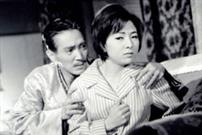|
|
||||
|
|
by Donald Levit  If the general public thinks at all of early post-WWII Japanese films -- ninety percent of pre-1945 production did not survive earthquakes, fire-bombings and Occupation, anyway -- samurai-ronin and sci-fi monsters come to mind, while casual art-house attendees will name Kurosawa, maybe Yoshimura, Ozu, Gosho, even Honda. Until the mid-‘60s, however, Shintoho (“New Toho,” formed during a 1947 Toho studio strike) churned out hundreds of shoestring features that much mirror that nation’s take on American genre movies. Cult classics at home but rarely screened abroad, eight of them comprise Japan Society’s Globus Series “Into the Shintoho Mind Warp: Girls, Guns & Ghosts from the Second Golden Age of Japanese Film.” All these New York premičres, on blu-ray in English-subtitled Japanese -- Japanese side-titles for lines in stilted English -- with only two in color, running a refreshing average eighty minutes, were first curated for the 2010 Undine Far East Film Festival. Ambition, vengeance, horror, escaped convicts, suggested lesbian and straight and bought sex, buried treasure and babes on tropical beaches -- ero-guro, the combination of erotic and grotesque -- call up Hollywood equally with Tokyo. As Ozu was to remember, domestic movies “had done nothing more than follow the plot, but when an American film was shown that was when I decided to be a film director.” Title Flesh Pier/Jotai Sanbachi from its Arizona nightspot’s nickname, writer-director Teruo Ishii’s club and piano player (Teruo Hata, as Teruo, the “Kid”) and cool dapper hero’s reencountering the love of his life, point to Casablanca and in style echo other U.S. films of the era. Pretending to be in the rackets, The documentary-style picture of the country’s flourishing sex industry is complicated with two other females: Haruko (Akemi Tsukushi), a “model” via the Grand Fashion Club but actually a Two years later, the same prolific Shintoho writer-director went himself one better. Also titled from its setting, listed as b&w but actually in faded noir-appropriate dark color, Yellow Line/Osen-Chitai goes beyond stock stick figures into deeper character ambiguousness. Not the typical bad guy with a good heart, a prison-born orphanage-raised betrayed-in-love hatchet man (Shigeru Amachi) is duped by whoever hired him to kill a Her reporter boyfriend Toshio (Teruo Yoshida) tracks the pair to If Ishii delights in noir twists, Kyotaro Namiki’s same-year Vampire Bride/Hanayome Kyuketsuma exhibits the straightforward plot and moral justice of B-horror. Its cursed heroine Shirai Fujiko is played by Junko Ikeuchi, the fresh-faced star here chastised for marrying contrary to studio wishes and then getting a divorce. A ballet hopeful caring for an elderly mother, she is the object of desire of local beaux and therefore of envious hatred of many local lassies (who gather in the slyly named Coffee Lumiere). Partial to Satoe, whose sister Sanae is a best friend, at this point she is intrigued by a likely film contract and the money to pay off her mother’s mortgage in arrears. SPOILER ALERT On a seaside outing, she is pushed over a cliff by jealous rivals, her face is scarred, and her distraught mother commits suicide. She seeks refuge with her Kageyama family great-grandmother, a crone sorceress who gives her death in order to revive her as a hairy shape-changing blood-sucking avenger that can morph into Sayoko, who looks like (and is) the presumed dead Fujiko. The feeble hunchback helper, squeaking bats, hokey magic and makeup, metamorphosis effects and fanged arm-flapper of a monster -- it seems that Japanese vampires inflict three puncture wounds instead of the West’s signature two -- would not be out of place in cheapo U.S. flicks of the time. One’s first thought is of legendary Plan 9 from Outer Space, released a year earlier and an equally fun watch for buffs. “Can you prove it didn’t happen? God help us in the future.” |
||
|
© 2025 - ReelTalk Movie Reviews Website designed by Dot Pitch Studios, LLC |



